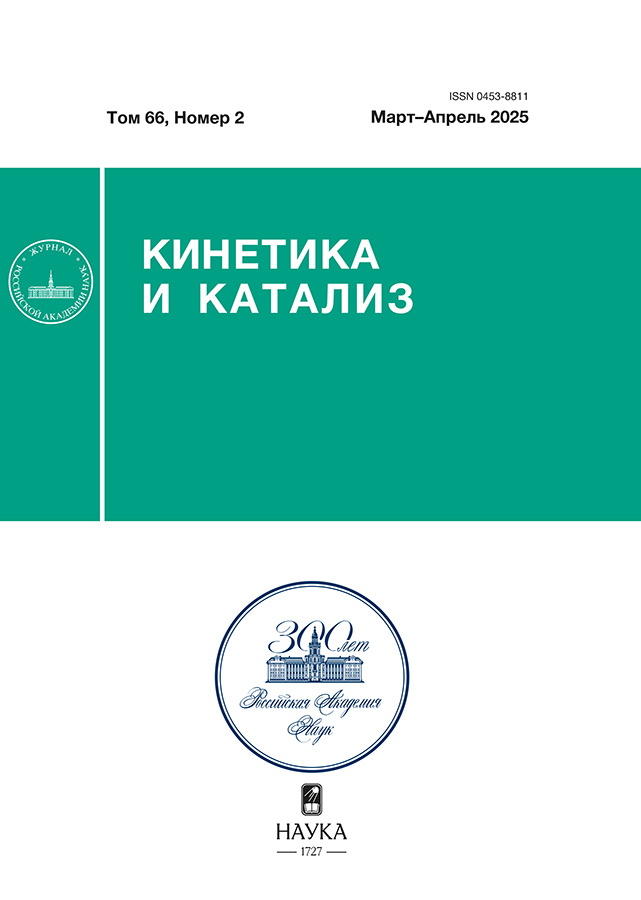Том 64, № 4 (2023)
ОБЗОР
Катализаторы жидкофазного окисления пероксидом водорода органических соединений: гомогенные и межфазные системы
Аннотация
В обзоре проведен сравнительный анализ перспективных гомогенных металлокомплексных катализаторов и представлены результаты исследований по синтезу и установлению структурных характеристик эффективных катализаторов окисления органических соединений пероксидом водорода – Q3{PO4[WO(O2)2]4} (Q – четвертичный аммониевый катион) – с привлечением методов EXAFS, SAXS, ЯМР-, КР- и ИК-спектроскопии. Рассмотрены возможности применения в условиях межфазного катализа бифункциональных гомогенных пероксополиоксокомплексов металлов в сочетании с органическими катионами, имеющими кватернизированный азот, на примерах реакций окисления пероксидом водорода органических соединений различных классов с получением востребованных продуктов – алифатических и ароматических эпоксидов, моно- и дикарбоновых кислот, а также биологически активных соединений медицинского и агропромышленного назначения.
 347-383
347-383


СТАТЬИ
Квантово-химическое исследование активации связи С–Н в метане на оксидных и сульфидных кластерах Ni–Cu
Аннотация
Методом функционала плотности PBE проведено моделирование разрыва связи С–Н в метане на Ni–Cu-кластерах, обогащенных медью, как первой стадии каталитической углекислотной конверсии метана. В качестве моделей катализаторов рассмотрены наноразмерные кластеры NiCu11S6(PH3)8, NiCu11S6, NiCu11O6(PH3)8, NiCu11O6. Рассчитана энергия связи метана с кластерами и определена энергия активация стадии \({\text{CH}}_{4}^{*}\) → \({\text{CH}}_{3}^{*}\) + H*. На основании полученных данных установлено, что каталитическая система NiCu11O6 является наиболее перспективной для активации CH4 как в кинетическом (энергия активации равна 99 кДж/моль), так и в термодинамическом отношении (изменение энергии стадии равно –29 кДж/моль). С целью оценки стабильности кластера NiCu11O6 к зауглероживанию проведено моделирование адсорбции CH с последующей диссоциацией (CH* → C* + H*). Рассчитанное значение энергии активации данной стадии достаточно высокое, 159 кДж/моль.
 384-393
384-393


ZnO, нанесенный на вьетнамский монтмориллонит: получение, характеризация и увеличение фотокаталитической активности в деградации родамина Б
Аннотация
В настоящей работе химическими методами с использованием нитрата цинка и альгината натрия в качестве прекурсора и стабилизатора соответственно получен нанокомпозитный материал – монтмориллонит/ZnO (MMT/ZnO). Синтезированные фотокатализаторы использованы для разложения родамина Б (RhB) в сточных водах производства красителей. Состав, морфология поверхности и структура полученных фотокатализаторов изучены методами энергодисперсионной рентгеновской спектроскопии (ЭДС), растровой электронной микроскопии (СЭМ) и рентгеновской дифракции (РФА). Промежуточные продукты разложения RhB идентифицировали с помощью жидкостной хроматографии-масс-спектрометрии. Результаты показывают, что наночастицы оксида цинка с гексагональной структурой вюрцита прикреплены к слоям монтмориллонита в соответствии со столбообразной структурой монтмориллонита. Эффективность разложения 10 ppm RhB в присутствии 0.1 г/л ММТ/ZnO под действием УФ-излучения С в течение 210 мин достигает 95.5%. Увеличение фотокаталитической активности ММТ/ZnO оценивали при варьировании различных рабочих параметров, таких как источник света, pH раствора, содержание катализатора, исходная концентрация раствора и неорганические поглотители. В настоящей работе кратко обсуждается также механизм фотокаталитической деградации RhB на MMT/ZnO.
 396-397
396-397


Дегидрирование метана и устойчивость к закоксовыванию поверхности Ni(111) анодов твердооксидных топливных элементов с различной степенью легирования Cu в соответствии с согласованной структурой DFT
Аннотация
Отложение углерода на анодах на основе никеля является ключевой проблемой для твердооксидных топливных элементов (ТОТЭ), использующих углеводородное топливо. Одним из решений является легирование другими элементами. В настоящей работе методом DFT были проведены систематические исследования процессов последовательного дегидрирования CH4, образования и удаления углерода с поверхности Ni(111), легированной различным количеством Cu. Легирующие концентрации Cu на поверхности Ni были 0, 1/9, 4/9, 5/9, 8/9 и 1 мл Ni(111), то есть Ni(111), NiCu1, NiCu4, NiCu5, NiCu8 и Cu9. Энергии адсорбции и центры адсорбции важных веществ были определены расчетным путем. Кроме того, в работе обсуждаются кинетика и термодинамика основных реакций и возможные пути удаления углерода. Предыдущие исследования показали, что введение меди ослабляет взаимодействие между поверхностью на основе никеля и адсорбатом, тем самым повышая активность различных частиц на поверхности катализаторов на основе никеля. Во-вторых, крекинг метана на поверхности на основе никеля происходит путем CH4 → CH3 → CH2 → CH, а пути на остальных пяти поверхностях такие же. Обнаружено, что добавление Cu может ослаблять адсорбцию C, ингибировать активность дегидрирования CH4 и способствовать связыванию C с промежуточной средой на поверхности на основе Ni, тем самым улучшая сопротивляемость к отложению углерода. Наконец, на основе расчетов DFT подробно обсуждаются несколько потенциальных путей удаления углерода, и сделан вывод, что проблема удаления углерода на анодах ТОТЭ должна быть сосредоточена на окислении CH, предотвращая прямой крекинг.
 394-395
394-395


Комплексы краун-эфиров с хлоридами щелочноземельных металлов – катализаторы распада гидропероксида изопропилбензола
Аннотация
Экспериментально получены кинетические и термодинамические параметры процесса распада гидропероксида изопропилбензола в хлорбензоле в присутствии комплексов дибензо-18-краун-6 эфира (ДБК) с CaCl2, SrCl2, BaCl2. Каталитическая активность соединений щелочноземельных металлов уменьшается в ряду SrCl2⋅ДБК > CaCl2⋅ДБК > BaCl2⋅ДБК. Кинетически установлено образование промежуточных интермедиатов в системе металлокомплекс‒гидропероксид. SrCl2·ДБК формирует наиболее прочные и упорядоченные структуры с гидропероксидом изопропилбензола, которые распадаются с наибольшими скоростями. С помощью квантово-химического моделирования подтверждено образование промежуточных интермедиатов.
 398-407
398-407


Кинетика и механизм реакции окисления СО в СО2 в каталитической системе PdBr2–CuBr2–ТГФ–Н2О
Аннотация
Исследована кинетика реакции окисления СО в СО2 в системе PdBr2–CuBr2–ТГФ–Н2О вне сопряженного процесса гидрокарбоксилирования циклогексена. Получена кинетическая модель и предложен механизм реакции. Установлено влияние реакции гидрокарбоксилирования алкенов на реакцию окисления СО в СО2 в сопряженном процессе, который был изучен ранее.
 408-417
408-417


7-я Международная школа-конференция молодых ученых “Катализ: от науки к промышленности”
MIL-100(Fe)/диатомит композиты для разложения фенола в реакции фото-Фентона
Аннотация
Получены пористые композиты на основе металлорганического каркаса MIL-100(Fe) и природного материала диатомита. Композиты характеризуются удельной поверхностью 322 и 441 м2/г и иерархической пористой структурой, представленной широкими порами исходного диатомита и узкими мезо- и микропорами сформированных частиц MIL-100(Fe). Изучено влияние подхода к синтезу на структуру композитов и каталитические свойства в реакции фотокаталитического разложения фенола. В композите, приготовленном с предварительной пропиткой диатомита раствором нитрата железа, частицы MIL-100(Fe) формируются в основном внутри пор диатомита. Образцы композитов проявляют каталитическую активность в разложении фенола в реакции фото-Фентона. Наибольшей активностью обладает образец, синтезированный без предварительной пропитки диатомита, для которого характерно формирование частиц MIL-100(Fe) преимущественно на внешней поверхности диатомита.
 418-427
418-427


Различение гомогенного и гетерогенного механизмов катализа “безмедной” “безлигандной” реакции Соногаширы методом анализа фазовых траекторий
Аннотация
В работе представлены результаты сравнительного исследования закономерностей дифференциальной селективности “безмедной” “безлигандной” реакции Соногаширы в условиях так называемой искусственной многомаршрутности, направленного на различение механизмов гомогенного и гетерогенного катализа. Применение различных количеств ряда растворимых и гетерогенных нерастворимых палладиевых предшественников катализатора приводило к одинаковым значениям величины дифференциальной селективности реакции по конкурирующим арилиодидам, конкурирующим арилацетиленам и продуктам их превращения. Наблюдаемые закономерности согласуются с протеканием реакции Соногаширы в растворе по механизму гомогенного катализа, в том числе в присутствии гетерогенных нерастворимых предшественников катализатора.
 428-436
428-436


Окисление 5-гидроксиметилфурфурола на нанесенных палладиевых катализаторах
Аннотация
Представлены результаты исследования катализаторов Pd/TiO2 и Pd/ZrO2, приготовленных методом пропитки с использованием разных условий термической обработки, в реакции окисления 5-гидроксиметилфурфорола (5-ГМФ). Катализаторы изучены методами РФА, РФС, низкотемпературной адсорбции азота и импульсной адсорбции СО. Каталитические исследования проводили в мягких условиях окисления 5-ГМФ: при температуре 80°C, давлении кислорода 5 атм и применении NaHCO3 в качестве щелочного агента. Показано, что условия температурной обработки существенно влияют на формирование активного компонента в Pd/TiO2 и Pd/ZrO2 катализаторах, определяя его дисперсность и взаимодействие с носителем и, как следствие, каталитические свойства получаемых материалов.
 437-446
437-446


Платиновые катализаторы на основе смешанных оксидов церия–циркония для паровой конверсии СО: влияние состава носителя
Аннотация
В работе исследовано влияние состава смешанных оксидов церия–циркония на структурную организацию и каталитическую активность в реакции паровой конверсии СО платиновых катализаторов на их основе (Pt/Ce0.75Zr0.25O2 и Pt/Ce0.4Zr0.5Y0.05La0.05O2). Структурная диагностика образцов проведена с использованием просвечивающей электронной микроскопии высокого разрешения, метода порошковой дифракции, хемосорбции СО и рентгенографического метода анализа распределения атомных пар. Показано, что катализаторы содержат ультрадисперсные частицы платины со средним размером не более 2 нм. Образцы на основе носителя Ce0.75Zr0.25O2 характеризуются более высокой дисперсностью частиц платины в связи с большей удельной площадью поверхности носителя. Показано, что катализаторы Pt/Ce0.75Zr0.25O2 и Pt/Ce0.4Zr0.5Y0.05La0.05O2 демонстрируют схожую эффективность при одинаковом содержании Pt. Сделано предположение, что удельная каталитическая активность, приведенная на один поверхностный атом Pt, выше в случае образцов на основе Ce0.4Zr0.5Y0.05La0.05O2, однако это преимущество, по-видимому, компенсируется более низкой дисперсностью нанесенного металла.
 447-456
447-456


Платформа iOk для автоматического поиска и анализа объектов на изображениях с использованием искусственного интеллекта в изучении нанесенных катализаторов
Аннотация
В работе представлена платформа iOk, объединяющая веб-сервис ParticlesNN и Telegram-боты DLgram и No Code ML для автоматического поиска и анализа объектов на изображениях с использованием искусственного интеллекта. Платформа позволяет работать с любыми видами изображений (электронная, зондовая, оптическая микроскопии, фотографии) любого качества без предварительных обработок. Пользователи имеют возможность самостоятельно обучать нейронную сеть на своих изображениях. Результат распознавания изображений – объекты, их площадь и размеры, а также положение на изображении. Сервисы находятся в свободном доступе, при этом для их использования навыки программирования не требуются. Платформа iOk – удобный для пользователей инструмент для работы с любыми видами изображений по автоматическому поиску объектов и определению их параметров.
 457-465
457-465


Модификация углеродного носителя катализаторов азотом путем обработки в NO
Аннотация
В работе предложен метод модификации углеродного материала Сибунит обработкой в NO в условиях статического реактора. Показано, что состав и содержание функциональных азот- и кислородсодержащих групп – определяется условиями обработки, а именно: температурой и продолжительностью, что позволяет управлять результатом модификации. Особенности модификации Сибунита в NO исследованы методами РФЭС и адсорбции N2. Предложен механизм модификации Сибунита травлением углеродных слоев в NO через превращение кислородсодержащих функциональных групп в NOx-группы (–NO и –NO2) и далее в пиридиновые и пиррольные группы. Разработанная процедура введения азота в углеродный материал проста в реализации, что важно для практических применений.
 466-473
466-473


Влияние состава и метода синтеза катализаторов на основе CoAl-гидроксидов на их свойства в реакции гидрирования фурфурола
Аннотация
Традиционным методом соосаждения и механохимическим способом синтезированы CoAl-гидроксиды с соотношением Co/Al = 2 и 4. Детально исследованы структурные свойства образцов на всех стадиях приготовления катализаторов, превращения, происходящие в ходе восстановления кобальта из соответствующих оксидов, текстурные характеристики прокаленных и восстановленных систем, а также размер, морфология и состав частиц, формирующихся после высокотемпературных обработок. Установлено, что способ синтеза CoAl-гидроксидов оказывает существенное влияние на фазовый состав и свойства полученных систем. Фаза слоистого двойного гидроксида формировалась только в случае использования метода соосаждения. Механохимический способ позволил получить материалы с более развитой удельной поверхностью. Согласно данным, ПЭМ образцы, синтезированные соосаждением (после окислительных и восстановительных обработок), имели структуру типа “ядро–оболочка”, где в состав ядра входили атомы металлического Co, а оболочка преимущественно состояла из CoAl-шпинели. Образцы, приготовленные механохимическим методом, имели на своей поверхности высокодисперсные наночастицы Со. Катализаторы, полученные на основе CoAl-систем, синтезированных механохимическим методом, обладали более высокой активностью в реакции гидрирования фурфурола: его конверсия достигала 97% для образца с соотношением Co/Al = 4. При этом селективность образования фурфурилового спирта для исследованных катализаторов составила практически 100% вне зависимости от метода синтеза и соотношения Co/Al.
 474-485
474-485


Исследование процесса активации никель-оксидных катализаторов, модифицированных кобальтом, церием, марганцем и цирконием
Аннотация
Исследован процесс активации и влияние модифицирующих добавок на фазовый состав и структуру серии катализаторов с общим составом Ni0.9M0.1O (M = Co, Ce, Mn, Zr), синтезированных методом соосаждения. Методом РФА изучено действие добавок на исходное состояние образцов, а методами in situ РФА и ТПВ-H2 – их роль в процессе восстановления NiO. Показано, что модификаторы изменяют структуру и микроструктуру исходных образцов, увеличивая удельную поверхность и уменьшая средние размеры ОКР NiO. Введение Mn, Co приводит к формированию с оксидом NiO твердых растворов замещения. Для Ce и Zr наблюдается выделение оксида CeO2 и рентгеноаморфного ZrOx. Их использование ведет к росту температуры восстановления NiO до металлического состояния по сравнению с массивным оксидом. Кроме этого, выявлено влияние модифицирующих добавок на размер частиц конечного металла. Использование Ce и Mn уменьшает средние размеры ОКР Ni в 2–5 раз по сравнению с массивным NiO.
 486-496
486-496












